| QR class | |||||||||||||||||||||||||||||||||
|---|---|---|---|---|---|---|---|---|---|---|---|---|---|---|---|---|---|---|---|---|---|---|---|---|---|---|---|---|---|---|---|---|---|
| |||||||||||||||||||||||||||||||||
| |||||||||||||||||||||||||||||||||
| |||||||||||||||||||||||||||||||||
| |||||||||||||||||||||||||||||||||
The QR class were a class of diesel locomotives in New Zealand and Tasmania. Originally built by Clyde Engineering between 1965 and 1966 as Queensland Rail's 1460 class locomotives. They were purchased by Tranz Rail in 1995 to be rebuilt, as a cheaper alternative to buying new locomotives. Seven were modified into the QR class. Three were leased to AN Tasrail for one year, but the locos were later sold in 2001. [1] [2] All three have since been scrapped. [3] [4]
Following the rebuilding of the DQ and QR class locomotives at Tranz Rails Hutt Workshops, Tranz Rail sold three QRs accompanied the second batch of DQ class locomotives due to a locomotive shortage due to the planned replacement of Tasrails English Electric locomotive fleet. The locos left the Port of Wellington on 8 December 1998 on the Arktis Dream, and arrived in Bell Bay on 15 December 1998. [1] They were still painted in the Cato Blue livery, still with Tranz Rails winged logo still painted on. [1] The logo was later modified with "Tranz Rail" being replaced by "Tasrail". [5] The locos were used as slave units only (as they were in New Zealand) due to lacking of the radio and other equipment as what are fitted to other lead locomotives. [4] The locomotives were also occasionally used for yard shunts. [4]
As of April 2017, all three locomotives have been scrapped. The three locos never saw much service in the first few years, with QR's 2062 and 2102 being placed into storage within the first year of service, [6] with QR 2056 following not long after. [4] The three later returned to service. QR 2102 withdrawn after a major engine failure in July 2002. [2] [4] QR 2056 was again withdrawn in August 2005. [2] By 2008, only QR 2062 remained in service. The loco was generally on the Melba Line, but was occasionally used on the South Line. [4] This locomotive was withdrawn by November 2009. [2] The locomotives were all stored at East Tamar Workshops after their withdrawals. The locomotives were then transported to OneSteel's scrap yard in Bell Bay in June 2012, where they were scrapped in a couple of months later. [7] [4]
The DQ and QR class were a class of diesel locomotives in New Zealand and Tasmania, Australia. Originally built by Clyde Engineering in the 1960s as Queensland Rail 1460 and 1502 class locomotives, they were purchased by Tranz Rail in 1995 to be rebuilt, as a cheaper alternative to buying new locomotives.
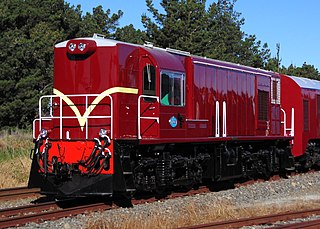
The New Zealand DI class locomotive was a class of diesel-electric locomotive in New Zealand. They were built by English Electric at their plant in Rocklea, Queensland in Australia. The class is very similar to the Queensland Railways 1620 class locomotives. At the time of their introduction, the class was seen as an alternative to the DB class for use on lightly laid secondary and branch lines, more so in the South Island. The World Bank financed introduction of the Japanese built DJ class in 1968, which ensured that no further DI class locomotives were purchased by New Zealand Railways.

Australian Transport Network (ATN) was a freight railway operator in Australia that commenced operating in November 1997. The company operated narrow gauge trains in Tasmania and standard gauge trains in New South Wales and Victoria. It was formed as a joint venture with Tranz Rail owning 67% and Wisconsin Central 33%. In February 2004, ATN was sold to Pacific National.

Bumble-Bee was an informal term, promoted by the editors of NZ Railfan magazine, describing a New Zealand railway locomotive livery found in common usage amongst the railfan community.
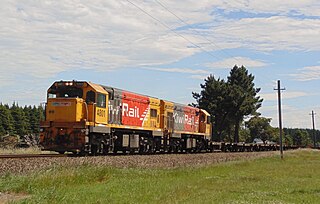
The New Zealand DC class locomotive is a type of diesel-electric mainline locomotive on the New Zealand rail network, operated by KiwiRail on freight trains, and formerly on long-distance passenger trains. The class was rebuilt from the DA class in the late 1970s and early 1980s, mainly in Australia. After the DA class, they were the most numerous class of diesel locomotive on New Zealand's railway network and remained numerically dominant until the mid-2010s when withdrawals began.
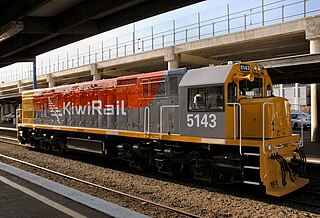
The New Zealand DX class locomotive is a type of diesel-electric locomotive that currently operates on New Zealand's national railway network. There are 49 of the locomotives and all are owned by KiwiRail. They have a Co-Co wheel arrangement.

The New Zealand DB class and DBR class locomotive is a type of diesel-electric locomotive built for service on New Zealand's rail network. They were built by General Motors Diesel (GMD) of Canada as a narrow-gauge version of the EMD G8 model, with seventeen locomotives constructed. Ten of these were later rebuilt into the DBR class.
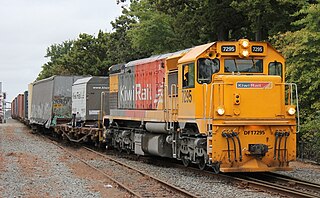
The New Zealand DF class locomotive of 1979 is a class of 30 Co-Co diesel-electric locomotives built by General Motors Diesel of Canada between 1979 and 1981. Between 1992 and 1997, all the locomotives were rebuilt as the DFT class, a turbocharged version of the DF.

The New Zealand DSC class locomotive is a heavy shunting locomotive used throughout New Zealand. The class was built in seven batches, the first 18 locomotives being built by British Thomson-Houston of the United Kingdom, with the further 52 locomotives being built by New Zealand Railways (NZR).
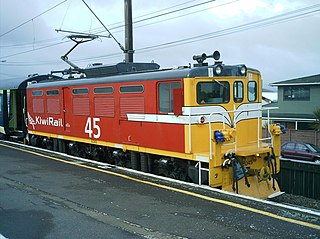
The New Zealand EA class of electric locomotives were used on the New Zealand rail network between 1968 and 1997 on the Otira – Arthur's Pass section of the Midland line in the South Island, through the Otira Tunnel. Following reconditioning, three were used by KiwiRail's Tranz Metro in Wellington from 2008 to 2011 to top and tail Metlink suburban passenger trains as an interim measure before new rolling stock arrived. Four of the five locomotives were scrapped in 2013 with one being set aside for preservation.
The Hutt Railway Workshops is a major railway engineering facility in the Lower Hutt suburb of Gracefield in the Wellington region of New Zealand's North Island. It is state-owned enterprise KiwiRail's only workshops, and was opened in 1930.
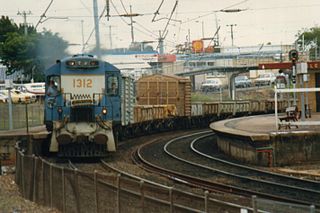
The 1300 class were a class of diesel locomotive built by English Electric, Rocklea for Queensland Railways between 1967 and 1972. They were later sold to AN Tasrail.

The WAGR A/AA/AB classes are classes of diesel locomotives built by Clyde Engineering, Granville, New South Wales, Australia, for the Western Australian Government Railways (WAGR) between 1960 and 1969.

The D/DA class are a class of diesel locomotives built by Clyde Engineering, Granville for the Western Australian Government Railways in 1971-1972.

AN Tasrail was an Australian railway operator that operated the Tasmanian rail network from March 1978 until November 2004. Originally a subsidiary of the Federal Government's Australian National, it was sold to Australian Transport Network (ATN) in November 1997. ATN was acquired by Pacific National in 2004 and the AN Tasrail subsidiary was later acquired by the Tasmanian Government in 2009 to become TasRail.
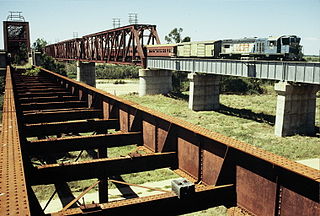
The 1460 class was a class of diesel locomotives built by Clyde Engineering, Eagle Farm for Queensland Railways between 1964 and 1966.

Cato Blue is an informal term describing a New Zealand railway locomotive livery found in common usage amongst the railfan community. The livery was first worn on DFT 7160 as a variation of the New Zealand Rail blue livery. With the introduced of Tranz Rail on 18 October 1995, the livery was adopted to replace New Zealand Rails blue livery, which was introduced in 1991. The scheme was known as Cato Blue after its creator, Cato Partners. DFT 7199 was the first locomotive repainted in the livery after Tranz Rail took over the rail system.

Corn-Cob was an informal term, promoted by the editors of NZ Railfan magazine, describing a New Zealand railway locomotive livery found in common usage amongst the railfan community. The livery was introduced on 5 May 2004 when Toll Rail took over the rail system from Tranz Rail and replaced the Bumble-Bee livery. The livery was replaced by the KiwiRail Phase One livery in July 2008. DX 5379 was the first locomotive to wear the livery. The livery represents the colours of Toll Rail and the colours of Australia. When KiwiRail took over the rail system from Toll, the Toll logos on the locomotives were covered or "patched" with the KiwiRail logo.

The DQ class were a class of diesel locomotives in New Zealand and Tasmania. Originally built by Clyde Engineering in the 1960s as Queensland Rails 1460 and 1502 class locomotives. They were purchased by Tranz Rail in 1995 to be rebuilt, as a cheaper alternative to buying new locomotives. Tranz Rail rebuilt 16 locos into the DQ class. Tranz Rail then sold the 12 DQs to AN Tasrail. Only eight out of the twelve DQs are still in service today.
The DC class was a class of diesel locomotives in New Zealand and Tasmania. Originally built by General Motors Canada and Clyde Engineering between 1955 and 1967 as New Zealand Government Railways DA class locomotive. Eighty-five DAs were rebuilt as the DC class locomotive. Tranz Rail, a successor of the NZGR, sold DC 4588 to AN Tasrail. It has since been scrapped.